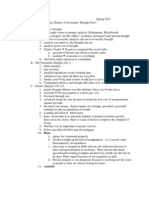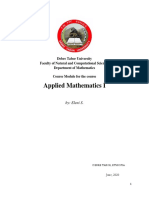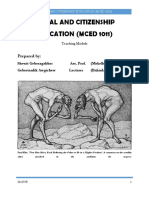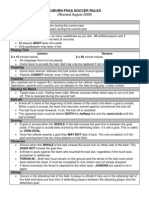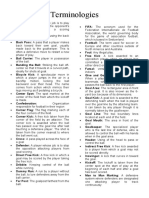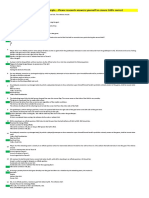Professional Documents
Culture Documents
Chap2 Gena
Chap2 Gena
Uploaded by
De CoubertinOriginal Description:
Copyright
Available Formats
Share this document
Did you find this document useful?
Is this content inappropriate?
Report this DocumentCopyright:
Available Formats
Chap2 Gena
Chap2 Gena
Uploaded by
De CoubertinCopyright:
Available Formats
Chapter two -Gena
2. Rules and regulations of Gena cultural sport of Ethiopia
2.1 History of Gena cultural sport
According to legends, the time at which when Gena was started in Ethiopia is not exactly known.
But it was played before the birth of Christ. Our forefathers said that shepherds used to play the
game in connection with Christ Mass Holiday from December to January up to the beginning of
the rainy season.
Mostly Gena is played after farmers collected their harvest in a flat field in the afternoon until
the time the sunsets.
First two team leaders will be appointed and a pair of players will secretly give a different secret
name themselves and they will tell this secret name to the appointed team leaders and the leaders
will select the players with that given secret name. The players will form a team in that way only
if the two teams are from the same villages and/or „Kebeles‟.
The game will be a high competition between two monasteries, areas such as the upper village
and the lower, between „kebeles‟ and those married and single. But the game has no limit of the
number of players in the old times by which a player comes in and comes of the playing field.
On the other hand, in some instances when a player is not able to continue the game due to
injuries team leaders or referees will be informed and another player may then be allowed to the
game as a substitute.
Players use a stick which has a curved part on its edge to kick, to roll and shoot the „Rur‟ (a
small ball like object used in „Gena‟ cultural game). Players dress a short trouser that comes
above their knee, a cloth which goes round their waist named «Dig» when they play.
In some areas when the game is held, team leaders will be accompanied with four border
defenders .The end of the game will then be either in a goal score or a point.
The game of „Gena‟ had been played in different forms. For example:-
A. as a form of „qurquz‟ (the form of a game played by shooting everything including the bodies
of opponents)
B. ‘Mucch‟ (This form of the game is played by sweeping the „Rur‟)
C. Shooting after controlling the „Rur‟ with a hand
D. Shooting by fully picking the „Rur‟ from the surface.
Cultural Games (BY-2023 G.C) Page 1
These different game forms will be played in the following circumstances
1. When there were special holidays they usually play the Shooting by fully picking the
„Rur‟ from the surface.
2. When people celebrate the rule of law they demonstrate with playing the game through
Shooting after controlling the „Rur‟ with a hand.
3. „Mucch‟ will be played if the players agree to play by sweeping the ball including their
legs
4. „Qurquz‟ on the other hand follows rules and it is played by rolling the ball like object of
the game called „Rur‟.
The following is a common proverb to show that the game is a game for all. This is the
proverb. “There is no master and servant in the game of „Gena‟ and master will not be
anger on the game of „Gena‟”. Players will not show revenge and create danger to their
opponents.
As the game shows progress the play ground is limited to have a length of 300 meter and
a width of 200 meter. The goal (culturally named „Lew’) will be recorded as a score when
it passes the specified border.
The game of „gena‟ is expanded and widely played in the regime of Emperor Minilik.
Studies disclose that adults used to sing and dance after the game walking through
different areas.
„Gena‟ at the moment becomes the most loved game in the world and became one of the
Olympic Games.
2.2 Meaning
The game of „Gena‟ contains 1 goal keeper and 9 players in the field having a total of 10 players.
The game of „Gena‟ is all about scoring the „Rur‟ which is made of plastic/stick/ or defending
the object from entering their goals. Players kick, pass the „Rur‟ to each other and roll and score
it to the goal.
Rule one the playing ground/field/
Article 1: The size and content of the playing field
1.1 The length of the field of „Gena‟ playing ground is 90-100 meter and its width is from 45
to 50 meter. The field should be prepared through a smooth level that could easily enable
the „Rur‟ to roll without difficulty on the ground.
Article 2: The determinant lines of the field
2.1 The playing field should be prepared three meters away from areas that are dangerous in
a visible area. The sides of the field are categorized as side-lines and back lines.
2.2 There should at least be a two meter space between the lines of the field and spectators.
Cultural Games (BY-2023 G.C) Page 2
2.3 In order to easily see the limits of the lines of the playing field a flag at each corner
having a length of 40 CM and a width of 25 CM are placed as an identifying and limiting
lines of the playing ground.
Article 3: Lines of the playing field
3.1 The lines of the playing field will be visibly bordered with gypsum having a width of 5
CM on the playing ground. And the lines will be part of the playing field.
Article 4: Areas of the Stopper/Goalkeeper/ of the game
4.1 The area of the goalkeeper has two stands on the right and on the left which is far away
from 1-50 meter. It is prepared in the form of a square having 6 meter.
Article 5: an area of a goal kick
5.1 The area of a goal kick is located in the goal area in a line that connects the side and the
front lines of the goal area and the area inside the square of the goal area.
Article 6: Penalty area
6.1 Penalty area is located 6 meters away to the playing field from the side angles of the goal
area. It is prepared 10 meter to the playing field from the goal area in a rectangular form.
Article 7: Penalty kick spot (penalty shoot point)
7.1 The point for a penalty kick is located 9 meters away from the center of the goal line.
Article 8: The Arc of a penalty area.
8.1 The Arc of a penalty area is formed at a 4 meter radius from the point of a penalty kick.
Article 9: the mid-line of a field
9.1 The mid-line (mid-field) of a playing ground divides the field in to two parts from its
length. It is a line that divides the playing field in to two.
9.2 The field of one team is the area from its goal to the mid-line (mid-field line of the field).
Article 10: „qurquz‟ Area
(In this area people are allowed to shoot everything including the bodies of opponents). It
is the circular area in the middle of the field which the game starts with the captains of
the two teams.
Cultural Games (BY-2023 G.C) Page 3
10.1 This area is located at a 4 meter radius in the circle in the middle of the field
10.2 „Qurquz‟ is used after a goal is scored to start the game by the Capitan‟s (Team leaders of
the two teams). This is a place where the game starts and restarts after a goal („Lew‟) is
scored.
Article 11 Corner kick areas
11.1 It is the line that connects the lines of the goal area and the sidelines. It is marked on a 1
meter circular quarter on the connection point.
Article 12 the goal of „Gena‟ cultural game
12.1 The goal of „Gena‟ is prepared from smooth or short metals that will come together
having a side length of 3 meter and 1 meter high.
12.2 The metal bars of the goal have a circular area of not more than 15 CM and not less than
10 CM.
12.3 The goal has a net which is prepared from garments. And the net is fixed with a sideline
bar 50 cm away from the goal bars.
12.4 The goal is located at the middle of the back side lines of the playing field.
Figure 1: The Goal
A C
Keys:-
A=3M
B = 1M
C = 50 cm
Article 13: the place where the corner flags are placed
13.1 Corner flag will be placed in all four corners of the playing field
Cultural Games (BY-2023 G.C) Page 4
13.2 The flag will be placed on 1 meter length stick at its top with 40x25cm garment.
Article 14: Technical area
14.1 Technical area is prepared parallel to half of the field 10 meters behind in the upper and
left-right areas at 3 meters distance.
14.2 Only team leaders, coaches, massaging professionals and substitutes are allowed to sit in
this area.
Cultural Games (BY-2023 G.C) Page 5
Figure 2: Gena playing Field
K D
4M
II
A
FE H C
EF J K
Keys
A = 45 - 50 M C=3M E=6M G = 1 M Radius I=4M K = 4.5 M
B = 90 – 100 M D = 1M F=6M H = 15 M J = 1.5 M
Cultural Games (BY-2023 G.C) Page 6
Figure 3: The stick of gena
E
C
F
Keys
A A= 1 m
D
B= < 25 cm
C= <10 cm
D = 1M
B
E = 40 cm
F = 25 cm
Rule two Materials used during competition
Article 15: The Playing stick of the game of „Gena‟
15.1 The playing stick that is used to play „Gena‟ has 1 meter length and has an arc at
the lower tip. The arc has a width not more than 25cm and has a maximum of
10cm thickness. Its weight is 500 to 550gm. The stick of „Gena‟ cultural game
can be prepared from wood, bamboo or plastic.
Article 16: The Playing “ball” of the game of „Gena‟
16.1 „Rur‟ (an object used like a ball in the game of „Gena‟) could be prepared from
plastic or related objects in a circular form visibly. It has a weight of 100gm and a
circular area of about 25-30 cm.
Rule Three Players
Article 17 the number of players
17.1 One team will have to register only 15 players of which 5 are substitutes and only
10 players of a team are allowed to play the game in the field at a time.
17.2 One of the ten players of a team is a Goalkeeper
17.3 And one of the players will be the captain of a team
Cultural Games (BY-2023 G.C) Page 7
17.4 The captain is the man in charge to report to the referee when the „Rur‟ is off
lines.
17.5 The captain is also the man in charge to direct players to play with fair play, sport
Ethics and sport discipline.
17.6 The captain will put an identifying symbol on his hand to be easily identified from
the rest of the players.
17.7 The smallest possible number of players allowed in the game of „Gena‟ is
7/seven/
Article 18 Substitutes
18.1 One team will register 5 substitutes and can replace them either one by one or all
of them at once
18.2 substitutions are allowed following the report of the coach to the referee who
registers goal scores and this referee will give sign to the main referee in the field
for the entry allowance. The substitute player will come in the field after the other
player leaves.
18.3 A player who is substituted once is not allowed to come again in the field.
18.4 All players could be replaced with the 5 substitute players except with the one
penalized with a red card.
18.5 All players who are valid according to the referees could join the team and play
the game until the maximum numbers of players reach 10.
Article 19 Dressing of the players
19.1 The dressing of the team should reflect the regions culture and it should be
suitable for the play
19.2 A team may register two different colors of sport wears
19.3 The sport wears of the team should not be identical. If the dressings accidentally
become similar, the host team is liable to change the sport wears. Where as if
both the teams are not in the locality of the tournament, first they will be allowed
to change their sport wears by agreement if not with a lottery chance.
19.4 A player could wear appropriate shoes or can play without shoes
Cultural Games (BY-2023 G.C) Page 8
19.5 Players wear a cover their forelegs to minimize leg injuries
19.6 The goal keeper will have an additional covers such as hand cover, leg and
reproductive organs cover to be safe from injuries.
19.7 A player of „Gena‟ can dress up all the above sport wears but not allowed to wear
cultural and modern jewelries
19.8 A player of „Gena‟ should be identified with a clear number on his front and back
upper body parts visible for the referees and spectators. The number on the
players will be written with 15cm length and 5 cm width.
Rule Four Referees
Article 20 Number of Referees
20.1 One main referee
20.2 Two assistant referees
20.3 One 4th referee
Article 21 Duties and responsibilities of the main referee
21.1 Manages and controls the game having the highest authority in the playing field
21.2 His decisions are ultimate in the field
21.3 Approves and disapproves goals
21.4 The main referee can cancel goals based on the rules of the game before the game
restarts.
21.5 He has a full right to give his own balanced decisions in cases of legal ambiguity
and absence.
21.6 He may reject and cancel the decisions of assistant referees when feels that their
decisions are incorrect.
21.7 He has also a right to exclude players, coaches and team leaders from the playing
field and area when feels that they are found to be violent and acting against the
principle of Fair Play.
21.8 Checks the appropriateness of players before the game and the exactness of the
scores after the game and lists discipline misconducts during the game.
21.9 He uses his whistle and symbol to express and direct players to start, stop, and to
give free kicks, corner kicks and penalties
Cultural Games (BY-2023 G.C) Page 9
21.10 The referee should come to the playing field 30 minutes before the start of the
game
21.11 He waits 15 minutes if a team is absent and announces that the team present wins
the game
21.12 He can make various decisions on discipline misconduct starting from the
dressing room on players within 24 hour ranges of the game.
21.13 He also has a right to give penalizing cards if players leave the playing fields
before the referee leaves the area.
Article 22 Duties and Responsibilities of Assistant Coaches
22.1 Assistant coaches stand at the right and left sidelines of the field and shows their
flag when the „Rur‟ comes out of the lines and shows the direction at which the
game shall continue.
22.2 Shows their flag when there is a substitute in accordance with the rule of the game
22.3 Gives full responses when asked by the main referee to give suggestions
22.4 They should come to the playing field before 30 minutes
22.5 The check the appropriateness of the goal areas and the playing fields
22.6 They will show to the main referee their flag when a ball is directed through the
goal sidelines by a defender as it is a corner kick or a goal kick
22.7 They will show to the main referee fouls and misconducts closer to them even if
they are not visible to the main referee.
22.8 They closely protect and supervise 4 meter areas.
Article 23 Duties and responsibilities of the 4th referee
23.1 Undertakes registration of players sitting 3 meters away from the half sidelines of
the field.
23.2 Registers goals when ratified by the main referee
23.3 Checks whether substitutes are registered before coming in to the field.
23.4 23.4 Identifies and registers with a special emphasis players penalized with
yellow and red cards.
Cultural Games (BY-2023 G.C) Page 10
23.5 Checks and rechecks his score list and the list of the main referee and facilitates
all referees to sign on the lists
23.6 At the time of emergency when the main referee is not able to continue in
managing the game and if there is no assistant referee who can replace him, the
fourth referee will be the man in charge to coordinate and continue the game.
Article 24 Symbols that referees use to communicate
24.1 Symbols used by the main referee
24.1.1 When the „Rur‟ comes above the knee of players the referee stretches his
right hand and whistles before the symbol
24.1.2 The referee shows the direction at which the Rur should be directed when it
goes out of the sidelines after the whistle
24.1.3 The referee whistles and shows a leg with his hand when a player stops the
„Rur‟ with his leg.
24.1.4 When the „Rur‟ becomes a goal, the referee turns his face and raises his two
hands to the starting mid-point („qurquz‟ point) to ratify the goal.
24.1.5 when it is a free kick the referee shows one of his hands to the point at
which the „Rur‟ should be kicked and his other hand to the direction at
which the kick should be directed.
24.1.6 He raises his hands after a whistle when there are fouls to show the direction
at which the free kick is given.
24.1.7 When there is a foul he shows either one of his hand to the direction of the
kick or he stand on the point at which the foul is made and shows one of his
hands to show the direction the „Rur‟ should be kicked
24.1.8 When there is a corner kick he shows one of his hands to the corner.
24.1.9 When the „Rur‟ goes out with the back sidelines of the field, he bends his
two hands and shows that it is either a corner kick or a goal kick.
24.1.10 He bends his palm to show that a player is playing without his role
24.1.11 He shows parts of his body to show that a player has touched the „Rur‟ with
that specific body
24.1.12 He whistles a long whistle and shows his two hands first by bending and
then shortening to show that it is the end of the game.
Cultural Games (BY-2023 G.C) Page 11
24.1.13 He shows his hands in the direction at which fouls should be directed when
players push, pull and or make any kind of foul to other players.
24.1.14 The referee raises his hand and forms a v-shape with his two fingers to show
that a player is hanged by two players.
24.2 Symbols of the an Assistant Referee
24.2.1 Shows that the „Rur‟ goes out of the sidelines and back lines with the flag
raised with a hand.
24.2.2 Directs his/her hand to the direction at which the „Rur‟ should be kicked
with a flag. Assistant referee stands showing their body to the field.
24.2.3 shows a flag when the „Rur‟ goes out of the back sidelines with one hand
24.2.4 If the „Rur‟ goes out through the back sidelines and if it is a corner kick the
assistant coach will direct his flag to the corner kick point.
24.2.5 If the ball is not a corner kick the assistant shows his hand to the goal keeper
to show that it is a goal kick.
24.2.6 Assistants will show their flags for fouls not seen by the main referee and
shows the direction of the free kick
24.2.7 They show their flags with their two hands to mean that there is a substitute
Rule Five
Identifying the winner of the game and about stopping the game
Article 25 The duration of the game
25.1 The game has a total time of 60 minutes divided into two half times and 10
minutes break after the first 30 minutes half time.
25.2 A time wasted during the first half will be added before the stoppage of the first
half and if there are wasted minutes on the second half, time will be added before
the end of the second half too.
Article 26 Extra time and identifying the winner
26.1 The winner of „Gena‟ cultural game will be identified by the number of goals at
the end of the stoppage time. A team that has more goal than the other will win
the game.
Cultural Games (BY-2023 G.C) Page 12
26.2 If the game is a knock out game, and if the two teams finish the regular time with
an equalizer, 20 minutes of extra time will be added. The 20 added minutes will
be divided in to two half‟s.
26.3 If the two teams are unable to win each other, the teams will be given three
penalty shots. And the penalty continues by adding one penalty after the three
shots until one of them wins the game.
26.4 The number of penalty players should be equal in both teams.
26.5 Players will not repeat penalty until all properly registered players kick the
penalty.
26.6 It is not obligatory to kick all the three penalty kicks
26.7 If the number of players of a team decreases because of any reason during the
penalty kick, the penalty will continue with the remaining players.
26.8 If a team is late for over 15 minutes of the starting time of the game, the team
present will be the winner.
26.9 If a team comes up with less than 7 players, they will be given 15 minutes to add
players and if they are able to add players and continue the game it will be
considered that they lost the game.
26.10 If a team has less than 7 players due to players‟ suspension, they will be
considered that they lost the game.
26.11 Three points will be given for a team scoring more goals during the game. If the
two teams complete the game with an equalizer they will have one point each. If a
team wins with the absence of the opponent team due to different reasons, the
team present will be a winner with three points and two goals. And the absent
team will have zero points with no goal.
Article 27 Terminating playing time of the game
A game could be forced to stop due to uncontrolled conditions such as heavy rain
and violence.
27.1 If the game could restart within 30 minutes, it will continue from the time
stopped in a bid to complete the remaining time.
Cultural Games (BY-2023 G.C) Page 13
27.2 If a game is not restarted for over 30 minutes and if the referee believes that it
should be repeated in another time, the issue will be presented to competition and
protocol committee and it will be held in another suitable time.
Rule Six. The start of the game and the fighting („Mekoraqoz‟) during the
start
Article 28 the start of the game
28.1 First the referee will make a lottery with the captain of the two teams for goal
selection.
28.2 The team leader who gets the lottery will select one of the two half sides of the
field.
28.3 The referee will put the „Rur‟ at the middle of the field (the fighting zone usually
termed as „qurquz‟) and let the captains start the game through fighting.
Article 29: „Mekorakoz‟ (the act of fighting at the beginning of the
game to get the „Rur‟)
29.1 „Mekorakoz‟ is the first part of „Gena‟ cultural game held by the captains of the
two teams. The captains stood at the middle of the field in the circular line and
say «Here is the „Rur‟, here is „Gena‟» three times and they start to kick the „Rur‟.
If anyone of the capitains tries to kick the „Rur‟ without saying «Here is the „Rur‟,
Here is „Gena‟» three times will get penalized.
29.2 The other players will stood on their position 4 meters away from the captains in
their own half fields.
29.3 The players may come inside and play outside the middle circular area with the
„Rur‟ to enable the captains‟ touch and start the game.
29.4 On the second half of the game the referee will let the captains fight to get the
„Rur‟ to start the game again.
29.5 The referee will make the game start after a goal is scored by allowing the
captains struggle to get the „Rur‟ with forceful activity.
29.6 The referee allows the two teams engage in the forceful „mekorakoz‟ when the
two teams change their goal area and starts an extra time.
29.7 Goal is said to be scored in the game of „Gena‟ when the „Rur‟ passes the goal
lines in a limited metal bars either in the ground or on the air.
Cultural Games (BY-2023 G.C) Page 14
29.8 The „Rur‟ may go up about 1 meter high in the goal area
29.9 If a team scores a goal that is in line with the rule of the game, the referee will
start the game by the aggressive start of the two captains (that is through the act of
„Mekorakoz‟).
29.10 A player can control, kick or pass the „Rur‟ to the right, left or behind to his team
mates if only he has 4 meters gap between another player/s/.
Rule Seven Goal kicks, sideline kicks and corner kicks
Article 30 Goal kicks
30.1 Goal kick will be given to a team if the ball goes out of the back sidelines of the
field by the shoot or touch of the players of a striking team.
30.2 Goal kick will be conducted by putting the „Rur‟ on left, right or middle lines in
front of the goal keeper area.
30.3 The „Rur‟ is said to be at play when it passes the goal area.
30.4 The player who kicks the Goal kick is not allowed to touch the „Rur‟ again before
other players get the kick.
30.5 The goal kick will be repeated if the kick is not able to pass the goal area lines or
the player who kicked the goal kick touches the „Rur‟ before any other player.
Article 31: Sideline kicks
31.1 If a team lets the ball out of the sidelines through touching, the opponent team
will put the „Rur‟ on the point it goes out and kicks the ball to the playing field.
31.2 If it is difficult to identify who lets the „Rur‟ out of the sidelines, the referee uses
„qurquz‟ or „mekorakoz‟ so that players of the two teams will look for the „Rur‟
forcefully.
31.3 The player of the defending team should stand four meters away from the kick
lines in the sideline kicks.
Article 32 Corner kick
32.1 Corner kick will be given to the striking team if the „Rur‟ goes out of the back
sideline of the defending team by the touch of defenders.
32.2 Corner kick will be kicked from any point of a quarter circular areas in the corner
of the field the ball goes out.
Cultural Games (BY-2023 G.C) Page 15
32.3 It is not allowed to displace the flag on the corner to kick the „Rur‟ from the
Corner.
32.4 The players of the defending team are allowed to stand four meters further against
the corner kick.
32.5 A defending player is not allowed to move to the „Rur‟ before the whistle in a bid
to defend at any circumstance.
32.6 At any circumstance a player who kicks the „Rur‟ is not allowed touching the
„Rur‟ before another player touches it.
Rule Eight
Article 33 Meaning of free kicks
33.1 Free kicks will be given when players make technical mistake in connection with
the game
33.2 Free kicks will be held at the area the fouls were made
33.3 When fouls were made inside the penalty area the „Rur‟ will go 4 meters away
from the defending payers to the penalty lines.
Article 34 Fouls that leads to free kicks
34.1 When the player plays or kicks the „Rur‟ from a distance less than 4 meters from
the other player.
34.2 When a player plays with the „Rur‟ that goes higher than his waist even if
collided with other objects.
34.3 shooting the „Rur‟ above the waist
34.4 Catching the „Rur‟ with a hand and then shooting
34.5 Trying to get the „Rur‟ with an increased number of players especially two or
more players from one team snatching for the „Rur‟.
34.6 If a player touches the „Rur‟ of a free kick before other players by kicking the ball
himself.
34.7 Making different fouls such as pushing, hanging the sport wears of players,
blocking players while running and pulling
34.8 playing by handing the stick of „Gena‟ above the waist
34.9 Violating the four meter distance gap
Cultural Games (BY-2023 G.C) Page 16
34.10 Controlling or playing with the „Rur‟ without the stick
34.11 If players get inside the goal keeper area
34.12 blocking the stick of the opponent with ones playing stick
34.13 playing by carrying a stick with one hand
34.14 If the Goal keeper plays out of the goal area and shoots the „Rur‟.
34.15 When conducts fouls twice other than penalty shots
34.16 Not successfully taking penalty at first shot
Rule Nine Penalty Shots
Article 35: Meaning and preconditions
35.1 Penalty shots will be given if the defending players conduct five major fouls
inside the penalty areas
35.2 All the players will stand behind the player who will kick the penalty 4 meters
away from the rays inside the goal area
35.3 The goal keeper will stand on the goal line during the penalty
35.4 The player who will kick the penalty should be clearly known.
35.5 Penalty shots should be kicked to the front but not to the back
Article 36 Fouls that leads to penalty
36.1 If the defender intentionally blocks or hits the opponent player with his stick, pull
or push the player in a bid to block him not to score a goal.
36.2 If the defender plays with the „Rur‟ without the stick in his own goal area while
he could use the stick
36.3 If a goal is blocked by any other means not allowed in the game
36.4 If the goal keeper touches the „Rur‟ with a hand putting his stick on the ground or
placing it in his armpit.
36.5 If a goal keeper picks the ball with his hand out of his goal area in the penalty
region.
Article 37: Actions to be taken during penalty shots
37.1 If a striking player/s/ passes the penalty region or the four meter rays, the goal
will be cancelled if scored or restarts as a goal kick if not scored.
37.2 If the defending player/s/ passes the penalty region or the four meter rays, the goal
will be registered if scored or the penalty will be repeated if not scored.
Cultural Games (BY-2023 G.C) Page 17
37.3 If players of both teams pass the penalty region or the four meter rays in the
region, the penalty will be repeated.
Rule 10: Fouls and forbidden acts
Meaning
Fouls and forbidden acts are conducted by the registered players of the two teams and
their substitutes inside or outside the playing fields. The acts are said to be disciplinary
misconducts.
Article 38: Acts that leads to yellow card
38.1 If a player delays the time of the game at any cost for his/his team advantage
38.2 If a player catches the „Rur‟ with his hand and shoots it.
38.3 Dropping intentionally the playing stick, kicking the ground with the stick,
throwing dusts, and soil, sand and grass dusts on players.
38.4 Being present on the playing field without having the playing stick
38.5 Opposing the decision of the referee verbally or non-verbally.
38.6 Conducting acts against the principles of sport and fair play.
38.7 Going in and out of the playing field without the permission of the referee
38.8 Not standing at four meter distance during different kicks
38.9 When a player took his shirt to express happiness or other emotions
38.10 Aggressive playing style and the act of threatening players with the playing stick.
Article 39: Fouls that leads to a Red card
39.1 Blocking the chance of the goal with an aggressive playing style intentionally
39.2 spitting on players or any other person
39.3 Coming into the field after using any kind of drugs
39.4 Insulting (using offensive words), fighting or advising for the acts
39.5 communicating the referee with rude words or insulting the referee
39.6 Making a foul that leads to a second yellow card
39.7 Insulting anybody verbally or non-verbally
39.8 Players removed from the field with a red card should leave the playing area or
the technical region and should sit with spectators.
Cultural Games (BY-2023 G.C) Page 18
You might also like
- IT Grade 11 Teachers' Guide Final VersionDocument126 pagesIT Grade 11 Teachers' Guide Final Versionreyxia19100% (1)
- Training DocumentDocument36 pagesTraining DocumentÃhmēd Męd100% (1)
- 2013 Joseph A. Luxbacher - Soccer-4th Edition - Steps To Success-Human Kinetics PublishersDocument272 pages2013 Joseph A. Luxbacher - Soccer-4th Edition - Steps To Success-Human Kinetics PublishersagusmulyaNoch keine Bewertungen
- Ethiopian Traditional Sports and Games - Tradit..Document1 pageEthiopian Traditional Sports and Games - Tradit..semabay100% (7)
- Communicative II, Unit 2 QuestionsDocument2 pagesCommunicative II, Unit 2 QuestionsAddis VLOG100% (3)
- History of Economic Thought Midterm - ReviewDocument7 pagesHistory of Economic Thought Midterm - ReviewUDeconNoch keine Bewertungen
- Basic Soccer RulesDocument3 pagesBasic Soccer RulesJOEMARPDEL100% (1)
- Chap3 KorboDocument9 pagesChap3 KorboDe Coubertin100% (4)
- Chap4 TigilDocument12 pagesChap4 TigilDe Coubertin100% (1)
- 2nd Semester PreEngineering (Natural Freshman) StudentsDocument4 pages2nd Semester PreEngineering (Natural Freshman) Studentsdursa100% (1)
- Shah Cultural GameDocument10 pagesShah Cultural Gameayusmarty2017Noch keine Bewertungen
- Applied Math - 1Document25 pagesApplied Math - 1Miley Girmay100% (2)
- Test-2 Basic Concepts in Arguments - SchoologyDocument11 pagesTest-2 Basic Concepts in Arguments - Schoologyfunny zone100% (1)
- Physics Remedial ExamDocument1 pagePhysics Remedial ExamLeony Panjaitan100% (1)
- Chap5 Gebeta-12 and 18 HoledDocument22 pagesChap5 Gebeta-12 and 18 HoledDe CoubertinNoch keine Bewertungen
- Addis Ababa Physics Model Examination For Grade 12 Ginbot .: General DirectionDocument8 pagesAddis Ababa Physics Model Examination For Grade 12 Ginbot .: General DirectionKhalid A.100% (3)
- (YDM) Physics Bahir Dar MidDocument10 pages(YDM) Physics Bahir Dar MidYdm DmaNoch keine Bewertungen
- Jimma University Department of Psychology Assignment Summary of Chapters 8-11Document15 pagesJimma University Department of Psychology Assignment Summary of Chapters 8-11emrannaser953Noch keine Bewertungen
- Grade 6 TBDocument159 pagesGrade 6 TBamboobestNoch keine Bewertungen
- Awal ProposalDocument18 pagesAwal Proposalfajji100% (1)
- GeES 1011 Slides Chapt 1-3Document130 pagesGeES 1011 Slides Chapt 1-3Teame Gebretsadik Mezgbe100% (3)
- CTE Grade 7 Text BookDocument189 pagesCTE Grade 7 Text BookAbdulhamid Seid50% (2)
- Pedagogy Course PPDocument190 pagesPedagogy Course PPAychluhm Tatek0% (1)
- Ethiopian ICT Glossary PDFDocument240 pagesEthiopian ICT Glossary PDFDaniel FikreNoch keine Bewertungen
- Chapter 3: Number System: Summary of Number SystemsDocument9 pagesChapter 3: Number System: Summary of Number SystemsdagneNoch keine Bewertungen
- Grade 10 History Unit FiveDocument32 pagesGrade 10 History Unit FiveBiruk MeseleNoch keine Bewertungen
- Department of Basic Course Group Assignment On The Course Geography of Ethiopian and The Horn (Gees-1011) Program: Extension Year: 1 Semester: 1Document1 pageDepartment of Basic Course Group Assignment On The Course Geography of Ethiopian and The Horn (Gees-1011) Program: Extension Year: 1 Semester: 1Sagni Tesfaye100% (2)
- ! Communicative English Language Skills II, DTUDocument32 pages! Communicative English Language Skills II, DTUmichael gorgeNoch keine Bewertungen
- English For Ethiopia: Grade 6Document3 pagesEnglish For Ethiopia: Grade 6Esrom Abebe100% (2)
- Kambata Nation, Clan ListDocument6 pagesKambata Nation, Clan ListAnonymous 6uJ2smoJXLNoch keine Bewertungen
- English For Ethiopia English For Ethiopia: Teacher'S Guide Teacher'S GuideDocument188 pagesEnglish For Ethiopia English For Ethiopia: Teacher'S Guide Teacher'S GuideTule AliyiNoch keine Bewertungen
- Moral and Citizenship Education (Mced 1011) : Prepared byDocument198 pagesMoral and Citizenship Education (Mced 1011) : Prepared byHENOK MNoch keine Bewertungen
- Chapter One Understanding Civics: Some Accepted DefinitionsDocument4 pagesChapter One Understanding Civics: Some Accepted Definitionsamani100% (1)
- History Model Exam For Remedial StudentsDocument18 pagesHistory Model Exam For Remedial StudentsnasibulammaNoch keine Bewertungen
- 1.football Field Measurement:-Field Length Width Big Field 120m 90m Small Field 90m 45mDocument18 pages1.football Field Measurement:-Field Length Width Big Field 120m 90m Small Field 90m 45mimnotokaysendhelpNoch keine Bewertungen
- Role of Gada System in Environmental ManagementDocument6 pagesRole of Gada System in Environmental ManagementAbdela Aman MtechNoch keine Bewertungen
- English Remedial ModuleDocument77 pagesEnglish Remedial ModulejimmegatkuothcholNoch keine Bewertungen
- Research Proposal On DecisionDocument45 pagesResearch Proposal On DecisionHamza Dawid HamidNoch keine Bewertungen
- New Chemistry CurriculumDocument111 pagesNew Chemistry Curriculumkiya0175% (4)
- Maths For Natural SciencesDocument5 pagesMaths For Natural SciencesEfrem Hirko Gufi50% (2)
- Application Form For PHD and Masters Programs 2022 and 23Document13 pagesApplication Form For PHD and Masters Programs 2022 and 23amin demisho100% (2)
- Exit Exam Private LawsDocument14 pagesExit Exam Private LawsBarzala Carcar100% (2)
- Problems and Prospects of Coffee Production and Marketing in EthiopiaDocument36 pagesProblems and Prospects of Coffee Production and Marketing in Ethiopiakassahun meseleNoch keine Bewertungen
- CTE Grade 7 Teachairs GuideDocument92 pagesCTE Grade 7 Teachairs Guideshureasmelash100% (2)
- Biology ExamDocument1 pageBiology ExamZemetu Gimjaw AlemuNoch keine Bewertungen
- Civics Ethical Education: Teacher Guide Grade 9Document184 pagesCivics Ethical Education: Teacher Guide Grade 9Hani Taye87% (15)
- Grade 7-Mathematics Fetena Net 7350Document252 pagesGrade 7-Mathematics Fetena Net 7350Bayissa Bekele67% (3)
- Guidelines For Ethiopian Government Scholarship AdmissionDocument27 pagesGuidelines For Ethiopian Government Scholarship AdmissionTarikua TesfaNoch keine Bewertungen
- Freshman Economics Unit 2 Part 1&2Document25 pagesFreshman Economics Unit 2 Part 1&2Estifanos Defaru100% (2)
- Letter of Sponsorship For Graduate Studies2Document1 pageLetter of Sponsorship For Graduate Studies2sebahedin mohammedNoch keine Bewertungen
- Gada SystemDocument10 pagesGada SystemBora Abe100% (1)
- Proposal Final Edited June 2021Document22 pagesProposal Final Edited June 2021Aboma Mekonnen100% (1)
- Addis Ababa University College of Education and Behavioral Studies Department of Special Needs EducationDocument23 pagesAddis Ababa University College of Education and Behavioral Studies Department of Special Needs EducationĒrmias Álemayehu100% (1)
- TERM PAPER of TaxationDocument25 pagesTERM PAPER of TaxationBobasa S AhmedNoch keine Bewertungen
- College of Education and Behavioral Sciences, Haramaya UniversityDocument23 pagesCollege of Education and Behavioral Sciences, Haramaya UniversityGarkebo BashaNoch keine Bewertungen
- 2019/20 Academic Year HPE Final Exam For Grade 10 Section - Teacher's Name: Mr. Eyob Z. Date: - Student's Name: Time Allowed: 1 00Document2 pages2019/20 Academic Year HPE Final Exam For Grade 10 Section - Teacher's Name: Mr. Eyob Z. Date: - Student's Name: Time Allowed: 1 00Dagim Tadesse100% (2)
- G-9 and 10 Practice QuestionsDocument11 pagesG-9 and 10 Practice QuestionsWesNoch keine Bewertungen
- Final Hawassa Univiersity Sumplementary ExamDocument3 pagesFinal Hawassa Univiersity Sumplementary ExamArgaw Asha100% (4)
- The Gonderian Period and Zemene MesafintDocument11 pagesThe Gonderian Period and Zemene Mesafintautisticuserr100% (4)
- Coc For Level One AgricultureDocument3 pagesCoc For Level One AgricultureRabira Nigussie100% (1)
- Communicative Lan. Skills II Assignments For All Freshman StudentsDocument9 pagesCommunicative Lan. Skills II Assignments For All Freshman StudentsBikila GeremewNoch keine Bewertungen
- Inclusiveness Chapter OneDocument155 pagesInclusiveness Chapter OneHlinaNoch keine Bewertungen
- KABADDI GroundDocument21 pagesKABADDI Groundpalas rohitNoch keine Bewertungen
- Clarification: Law 16 - The Goal KickDocument2 pagesClarification: Law 16 - The Goal KickAleksandar StavrevNoch keine Bewertungen
- Free KickDocument17 pagesFree Kickandres camilo rivero bautistaNoch keine Bewertungen
- Soccer RulesDocument3 pagesSoccer RulesernsteinsNoch keine Bewertungen
- Soccer Coverage Standards PDFDocument22 pagesSoccer Coverage Standards PDFSeby YacobNoch keine Bewertungen
- Football Coaching ManualDocument52 pagesFootball Coaching ManualJince GomezNoch keine Bewertungen
- Aneisha Hope PE SBADocument22 pagesAneisha Hope PE SBAShawdy 502Noch keine Bewertungen
- Report On FootballDocument24 pagesReport On FootballSohel Mahmud0% (1)
- PE3 Football HandoutsDocument6 pagesPE3 Football HandoutsyhettNoch keine Bewertungen
- Reviewer Pe4 Soccer CategoryDocument4 pagesReviewer Pe4 Soccer CategoryneilNoch keine Bewertungen
- Goalie Wars ExtrasDocument37 pagesGoalie Wars ExtrasDiego SañudoNoch keine Bewertungen
- Football Coaching ManualDocument161 pagesFootball Coaching ManualNedu IulianNoch keine Bewertungen
- If You Are Not Mohd Tarmizi Tarmizi Please Destroy This Copy and Contact WORLD CLASS COACHINGDocument37 pagesIf You Are Not Mohd Tarmizi Tarmizi Please Destroy This Copy and Contact WORLD CLASS COACHINGwan mohd tarmizi100% (1)
- Sectorball: Sectorball Is A Sport. It Is A Version ofDocument3 pagesSectorball: Sectorball Is A Sport. It Is A Version ofjakeNoch keine Bewertungen
- Guidance For Officials - Officiating Youth Football - March 2018Document21 pagesGuidance For Officials - Officiating Youth Football - March 2018Michael RobsonNoch keine Bewertungen
- FIELDGAMELAWS 2007 BookletDocument18 pagesFIELDGAMELAWS 2007 Bookletdavid riveraNoch keine Bewertungen
- Module 2Document3 pagesModule 2Hamika DomcamNoch keine Bewertungen
- WMF Rules of The Game Edition 2023Document104 pagesWMF Rules of The Game Edition 2023Pic HuntNoch keine Bewertungen
- Indoor Soccer Futsal Rules 1Document12 pagesIndoor Soccer Futsal Rules 1Capt BilzzzNoch keine Bewertungen
- Learn To Train U9-U12: Curriculum: Grassroots ProgramDocument22 pagesLearn To Train U9-U12: Curriculum: Grassroots ProgramDanail IvanovNoch keine Bewertungen
- Football - Aldi Miniroos Collateral - Playing Formats RulesDocument5 pagesFootball - Aldi Miniroos Collateral - Playing Formats RulesRonald BosNoch keine Bewertungen
- PE 3 - Module 1 (History and Field of Play)Document8 pagesPE 3 - Module 1 (History and Field of Play)VienNoch keine Bewertungen
- FHSAA Test 2016-2017 Sample .Please Research Answers Yourself To Ensure 100% CorrectDocument4 pagesFHSAA Test 2016-2017 Sample .Please Research Answers Yourself To Ensure 100% CorrectMOEDNoch keine Bewertungen
- Mini Soccer and Youth Futsal Handbook 2020Document62 pagesMini Soccer and Youth Futsal Handbook 2020quavail.l.daileyNoch keine Bewertungen
- 13th Monfort Cup InvitationDocument3 pages13th Monfort Cup InvitationLakanPHNoch keine Bewertungen
- Soccer Rules: Juana Cuamatzi Joel Arroyo Amaury Palomares Pedro MejíaDocument17 pagesSoccer Rules: Juana Cuamatzi Joel Arroyo Amaury Palomares Pedro MejíaPedro CarriloNoch keine Bewertungen
- Football HistoryDocument13 pagesFootball HistoryMarkdwel Curpin0% (1)
- مصطلحات كرة القدم ١Document38 pagesمصطلحات كرة القدم ١MrmohanakNoch keine Bewertungen





